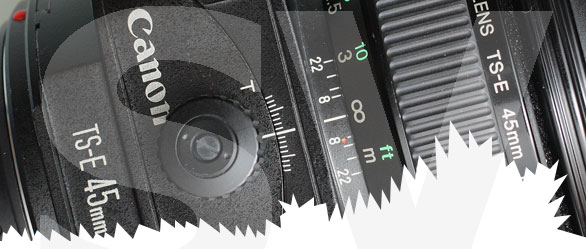
Canon TS-E 45mm f/2.8

Canon TS-E45mm f/2.8 doesn't have any special glass elements and construction looks
like medium format wide angle lens. Minimum focus distance is 40cm, which 0.16x maximum
magnification. Aperture has 8 aperture blades. Bokeh quality is better than average,
however there ain't that much bokeh due to small focal length of the lens.
Handling is pretty good on and from other point of view not so good. Manual focusing
is excellent, it takes about 160 degree turn to focus from minimum focus distance to
infinity. Manual focus is very good but not at same level with Leica or Carl Zeiss
lenses, however comparing to other Canon lenses it's very good. This might be because
this lens doesn't have autofocus and therefore focus mechanism can be designed for
manual focus only.
The bad thing about handling is that lens weight is 645g, which is pretty much for
45/2.8, so if weight is important for you make sure you take all out from the special
functionalities of the lens. One minor design flaw when combined to current
DSLRs: with 1.6 crop you could used full shift to any directions. However when doing
this in certain positions (e.g. rotate the lens 30 degrees) lens will make contact
with the flash assembly at 9.5mm shift position.
All TS-E lenses can be used with 1.4x and 2.0x teleconverters. Personally I'm a little
bit suspicious about the image quality since teleconverters are supposed to be optimized
for longer lenses.
Using without tilt and shift
Leaving tilt and shift into middle position this lens can be used as normal 45mm
f/2.8 lens. Image quality is pretty good, sharpness is very good. However micro
contrast is not at same level as Carl Zeiss lenses. Overall contrast could use
more "punch", as well as colors, however these are correctable in digital darkroom
unlike lack of micro contrast.
Tilt
To be added:
- Explain tilting the focal plane
- Include example of making cityscape look like a miniature/toy city
- Include example of extending depth of field by tilting
Shift
Perspective
To be added:
- explanation of convergence of vertical lines due to tilting camera upwards to fit
building into picture
- tell about how it can be also used to exaggerate perspective adjusting to wrong
direction
- include example picture of convergence of vertical lines
Using shifting to take panoramas
By using shift lens it's possible to take multiple photos using tripod which
can be combined together in PhotoShop. You can do this any lens, but when
it's done with shift lens pixels don't have to be remapped due to perspective
calculations. In my experience this gives benefit of sharper pictures on very
large print sizes. In order to use this technique camera has to be on
solid tripod. Highlighting solid since you have to move shift between
exposures without moving the camera.
Based on following assumptions I did draw illustrations of Canon TS-E lens
shifting capabilities:
- image circle (gray circle) is 58.6mm in diameter
[source]
- on vertical direction full 11mm of shift can be used
- on horizontal direction only 8.5mm of shift can be used (on 1.6x full 11mm
shift is assumed)
- 1.0x = 36mm x 24mm and 1.6x = 22.2mm x 14.8mm

Full Frame (1.0x) panorama picture width & height:
- 2.2:1 (36mm + 8.5mm + 8.5mm = 53mm, 53mm x 24mm, diagonal 58.2mm)
[green + blue]
- 1:1.3 (24mm + 11mm + 11mm = 46mm, 36mm x 46mm, diagonal 58.4mm)
[yellow + red]
Cropped body (1.6x) panorama picture width & height:
- 3.0:1 (22.2mm + 11mm + 11mm = 44.2mm, 44.2mm x 14.8mm, diagonal 46.6mm)
[green + blue],
example
- 1:1.7 (14.8mm + 11mm + 11mm = 36.8mm, 22.2mm x 36.8mm, diagonal 43mm)
[yellow + red + one frame without shift]
On my personal point of view panoramas are the most important reason to
have this lens. Perspective corrections are not needed very often on 45mm
and I'm neither finding the tilt functionality very useful in addition to
few test shots. See also my article about
Panoramic photography.
Summary [not final verdict yet, I need to do more photographing with
this lens first]
Pros:
+ Very sharp lens, on same level as
Contax Distagon T* 28mm
f/2.8 at optimum apertures, however micro contrast is not as good as with
Carl Zeiss lenses
+ Bokeh quality
+ Tilt & Shift functionality: operation to both direction, good handling
+ Manual focus feeling very good for Canon lens
+ Good focal length for panoramas
Cons:
- Strange CA when tilted
- The alignment of tilt and shift are not user changeable, not a big thing
for myself
- Pretty heavy and big for 45/2.8
See
photos
in my picturebank taken with this lens.
Tilt and shift lenses (regarding all TS-E lenses)
TS-E 45/2.8 on the-digital-picrure.com
TS-E 24/3.5 on the-digital-picrure.com
TS-E 90/2.8 on the-digital-picrure.com
Sports with TS-E lenses by Vincent Laforet for the NY Times
Fred Miranda - how to correct CA when shift used
Cambridge in colour - Shift
Cambridge in colour - Tilt
Photos of Canon TS-E45mm f/2.8
Tilt and Shift

Canon TS-E45mm f/2.8 full tilt left, right and full 11mm shift to left and right.
Shift with Canon EOS 20D

Full shift down (used for example when photographing cityscape from
higher building), no shift and full shift up (used for example when
photographing building from ground and tilting whole camera back would
make the building look like they are narrower from the top).
|




